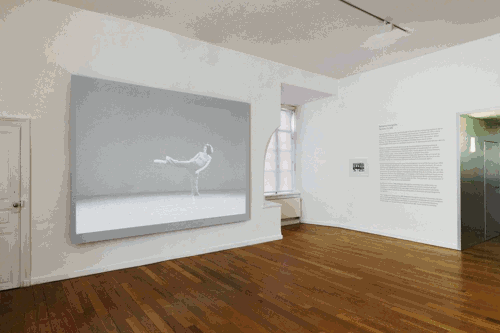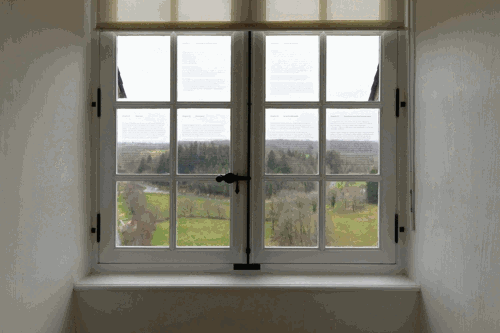Solo Show at Rochechouart Museum of Contemporary Art, France
Director / Curator Sebastien FAUCON
The solo show occupied three floors of the museum set in a Renaissance castle in Rochechouart in Limousin, in the
center of France. It constituted a mini retrospective of Mangolte's versatility in the presentation of still
images with time based works and installations plus two site-specific new works, one that reacted to frescoes from the
15th century of a room in the first floor and another work, which pointed to the view of the crater left by a meteorite
many millennia ago called "Rochechouart Astroblème" seen from the second floor of an Aichaugette, a reminder of the
Medieval origin of this Renaissance castle.
The first floor was opposing black and white photographs accompanied with a film in the entrance to the first floor
(Salle 1) and Long Gallery (Salle 3) that were highlighting Mangolte's interest in dance photography and graphic montage
of old building in New York City. Going from Salle 1 to Salle 3 you were passing by the Installation "Eloge du Vert" that
is about color variations and is composed of digital images with 3 large screens projections (Salle 2) and a site specific
film projection integrated in Salle des Chasses with frescoes from the fifteen century (Salle 4).
The first floor permitted the visitor to experience going from Black and White works to use of Colors in other works
as well as confronting how film makes you stop and looks for a little longer than still images. You were tempted by
distraction and hopefully surprised by what you saw. Every room had its own rhythm.
First Floor Slideshow:

The second floor had only three rooms of Mangolte's work while the remaining part of the floor was a selection of the
museum collection that were in conversation with the principal show Spaces to SEE.
The first room (Salle 9) had several films being screened "There? Where?", "Visible Cities" two films about condominiums
in California and a dance film Staging Lateral Pass about Trisha Brown working with her dancers on a stage with a complex set
and costumes by Nancy Graves. This choreography was also represented in the selection of dance photographs on the first floor.
The new piece was made with Viktor Klemperer's quotations from The language of The Third Reich, published in 1947 in German.
Those quotes were numbered chronologically and analyzed the progression of the demonization of Jews by the Nazi power.
The same mechanisms are still used today in the public sphere. You see out your window a world that is familiar to you but
around it, arguments about hate of others being Jews or Muslims used 85 years ago are being reactivated now by extremism groups
here and abroad in particular in social networks.
The second room (Salle 10) was an installation from 2008 "Collision". This room was divided in two sides. In one you saw a
film shot in continuity at night with no cut that was more than 20 minutes long with a music composition inspired by Ravel?s
Bolero. The other side of the room had a short five minutes film made of jump cuts intercut quickly as a back and forth between
two kinds of tree leaves on a windy day. Near the film screen, you had a first version of TOUCHING, a table top with digital
prints of dance images that permitted the viewer while glancing at the film to also touch the prints of different sizes on the
table.
TOUCHING explores the choices a photographer has to make before printing: which image to print and at which size? Wait until
the composition makes sense and grab the moment, then compare and decide, this is basically what being a photographer and
photography is about. The installation was opposing two ways to conceive filming as a continuum or as opposition with rapid
cutting between two different states. The work on the table permits to experience the choices to be made by the photographer.
In a small room used for firing on the invader in Medieval times and not visible at first when entering the room with
Collision, you could see the view of the "Astrobleme" and at 90 degrees angle a small video projection of how this landscape
that seems so peaceful now could be affected by Flood, Mayhem and Cataclysms in the future.
Second Floor Slideshow:

The third room (the Tower) was totally dark and set as a film theater where two films "The Camera: Je, La Camera: I" from 1977
and "The Sky on Location" from 1982 were shown in their entirety. Seating was provided and scheduling of the film was posted
outside the room.
The third floor was totally occupied with films screenings and the restaging of a film installation from 2008 in the spectacular
top floor of the castle with its wood ceiling.
You enter and saw PRESENCE from 2008 where the two film screens showed different editing of mostly exterior locations with insert
of domestic spaces. The films made you reflect on the living spaces in a California setting of roads and gardens shot in the 1990s
in 16mm. One film had sound the other one was silent, so looking with sound or without was something to discover.
Moving on, you saw facing each other two short film portraits Yvonne with Tape (1972) and Portrait of Richard Serra (shot in 1977
and edited in 2007 in HD video), then a small screen Patricia Patterson Paintings (shot in 1989/ 1990 an edited in 2012 in HD video).
Those 3 films were silent.
The large screen at the far end of the floor was Edward Krasinski's Studio (shot in 2011 in Warsaw, Poland and edited in 2012).
The film had sound that was very important to assert the authenticity of the space that was created out of small objects, photo
replicas and some blue tape.
Third Floor Slideshow:

|